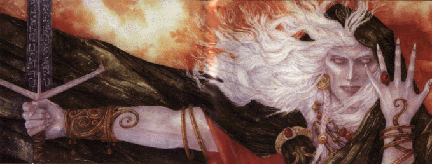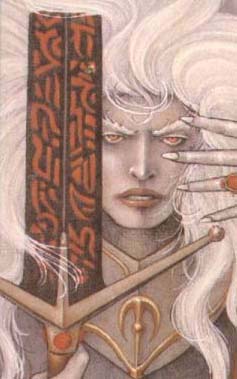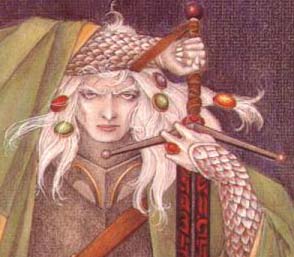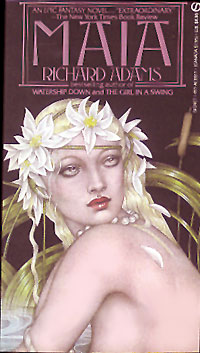
The best-known character with albinism in the traditional fantasy genre
would most likely be Michael Moorcock's Elric of Melniboné, around
whom several series revolve. Heir to the rule of a land that must be
purged of evil, Elric embarks on numerous quests to save his
kingdom.
 Like nearly all other
depictions of albinism, Elric's physical features are exaggerated for dramatic
effect: "It is the color of a bleached skull, his flesh; and the long
hair which flows below his shoulders is milk-white. From the tapering, beautiful
head stare two slanting eyes, crimson and moody, and from the loose sleeves
of his yellow gown emerge two slender hands, also the color of bone." His
looks never fail to elicit insults from his enemies. Like nearly all other
depictions of albinism, Elric's physical features are exaggerated for dramatic
effect: "It is the color of a bleached skull, his flesh; and the long
hair which flows below his shoulders is milk-white. From the tapering, beautiful
head stare two slanting eyes, crimson and moody, and from the loose sleeves
of his yellow gown emerge two slender hands, also the color of bone." His
looks never fail to elicit insults from his enemies.
The erroneous equation of albinism with poor health is exemplified
in this epic: Elric is described as having a weak constitution and
being completely dependent upon supernatural means for his continued survival,
"an albino kept alive by drugs and magic." His enchanted sword Stormbringer
is central to the plot and to his success, lending him exceptional skill
and strength that he would otherwise lack. One of the major themes
within the saga, in fact, is Elric's love-hate relationship with the magical
weapon, and his internal struggle to temper his own susceptibility to its
powerful and sometimes malevolent influence.
 On the positive side, Elric's
albinism is not viewed with the blatant revulsion pervading other works.
For a change, his unconventiaonl appearance is considered quite handsome
and he enjoys romantic liaisons with several women. He is also sharp
of wit and has a complex, alluring persona. He achieves a great
deal during the course of these swashbuckling adventures, and is fondly
regarded by both his comrades and Moorcock's readers. Moorcock's books
have a sizable cult following, and the establishment of a popular fantasy
imprint, White Wolf Publishing, was inspired by the success of the Elric
Saga (one of Elric's epithets is "White Wolf"). On the positive side, Elric's
albinism is not viewed with the blatant revulsion pervading other works.
For a change, his unconventiaonl appearance is considered quite handsome
and he enjoys romantic liaisons with several women. He is also sharp
of wit and has a complex, alluring persona. He achieves a great
deal during the course of these swashbuckling adventures, and is fondly
regarded by both his comrades and Moorcock's readers. Moorcock's books
have a sizable cult following, and the establishment of a popular fantasy
imprint, White Wolf Publishing, was inspired by the success of the Elric
Saga (one of Elric's epithets is "White Wolf").
 Pale-skinned, white-haired characters are often found inhabiting the realm of Faerie, usually taking the forms of nymphs, elves, or winter queens. In Wendy Froud and Terri Windling's lavishly illustrated children's story, Midsummer Night's Faery Tale, one fairy named Rianna (left) is described as having a "porcelain face" with "hair as white as soft new snow." Her beauty is bewitching, and she uses it to her advantage as she tries to steal the crown of the reigning Winter Queen, Titania. Pale-skinned, white-haired characters are often found inhabiting the realm of Faerie, usually taking the forms of nymphs, elves, or winter queens. In Wendy Froud and Terri Windling's lavishly illustrated children's story, Midsummer Night's Faery Tale, one fairy named Rianna (left) is described as having a "porcelain face" with "hair as white as soft new snow." Her beauty is bewitching, and she uses it to her advantage as she tries to steal the crown of the reigning Winter Queen, Titania.
 The cover of award-winning author Richard Adams' fantasy epic Maia (right), the tale of a simple country-girl-turned-legend, is a noteworthy one. Maia is not portrayed as having albinism; she is described as fair-skinned but with golden hair rather than the traditional white tresses. However, ironically, the coloring of the woman drawn on the cover is actually closer to that of real people with albinism — pink tones in the skin and yellow-cream tones in the hair instead of both being pure white, and blue eyes instead of red ones — than most graphical renditions of characters who are intended to be albino. The cover of award-winning author Richard Adams' fantasy epic Maia (right), the tale of a simple country-girl-turned-legend, is a noteworthy one. Maia is not portrayed as having albinism; she is described as fair-skinned but with golden hair rather than the traditional white tresses. However, ironically, the coloring of the woman drawn on the cover is actually closer to that of real people with albinism — pink tones in the skin and yellow-cream tones in the hair instead of both being pure white, and blue eyes instead of red ones — than most graphical renditions of characters who are intended to be albino.
 White Jenna, the protagonist of Jane Yolen's fantasy novel of the same name, is revered for her startlingly fair hair. Although albinism isn't necessarily the cause of it — her eyes are black and no mention is made of particularly pale skin — her hair color is her most salient characteristic, and its whiteness serves as a symbol of her perceived divinity. Her hair is said to be "white as the moonlight... whiter, for it had no shadows." From birth, Jenna is considered a prophetic vision made manifest, embodying both the White Goddess and the warrior queen foretold to conquer menacing forces beyond the boundaries of her walled community. Despite her own confusion and doubt about being the true Anna, or White One, the courageous and beautiful Jenna accepts both the fateful quest and the burdensome title bestowed upon her out of a sense of duty to her people. The elevated status she is accorded because of her white hair is reminiscent of Native American legends describing sacred albino animals, as well as the White Goddess archetype that appears in many other ancient earth-based religions.
White Jenna, the protagonist of Jane Yolen's fantasy novel of the same name, is revered for her startlingly fair hair. Although albinism isn't necessarily the cause of it — her eyes are black and no mention is made of particularly pale skin — her hair color is her most salient characteristic, and its whiteness serves as a symbol of her perceived divinity. Her hair is said to be "white as the moonlight... whiter, for it had no shadows." From birth, Jenna is considered a prophetic vision made manifest, embodying both the White Goddess and the warrior queen foretold to conquer menacing forces beyond the boundaries of her walled community. Despite her own confusion and doubt about being the true Anna, or White One, the courageous and beautiful Jenna accepts both the fateful quest and the burdensome title bestowed upon her out of a sense of duty to her people. The elevated status she is accorded because of her white hair is reminiscent of Native American legends describing sacred albino animals, as well as the White Goddess archetype that appears in many other ancient earth-based religions. |

 Like nearly all other
depictions of albinism, Elric's physical features are exaggerated for dramatic
effect: "It is the color of a bleached skull, his flesh; and the long
hair which flows below his shoulders is milk-white. From the tapering, beautiful
head stare two slanting eyes, crimson and moody, and from the loose sleeves
of his yellow gown emerge two slender hands, also the color of bone." His
looks never fail to elicit insults from his enemies.
Like nearly all other
depictions of albinism, Elric's physical features are exaggerated for dramatic
effect: "It is the color of a bleached skull, his flesh; and the long
hair which flows below his shoulders is milk-white. From the tapering, beautiful
head stare two slanting eyes, crimson and moody, and from the loose sleeves
of his yellow gown emerge two slender hands, also the color of bone." His
looks never fail to elicit insults from his enemies.
 On the positive side, Elric's
albinism is not viewed with the blatant revulsion pervading other works.
For a change, his unconventiaonl appearance is considered quite handsome
and he enjoys romantic liaisons with several women. He is also sharp
of wit and has a complex, alluring persona. He achieves a great
deal during the course of these swashbuckling adventures, and is fondly
regarded by both his comrades and Moorcock's readers. Moorcock's books
have a sizable cult following, and the establishment of a popular fantasy
imprint, White Wolf Publishing, was inspired by the success of the Elric
Saga (one of Elric's epithets is "White Wolf").
On the positive side, Elric's
albinism is not viewed with the blatant revulsion pervading other works.
For a change, his unconventiaonl appearance is considered quite handsome
and he enjoys romantic liaisons with several women. He is also sharp
of wit and has a complex, alluring persona. He achieves a great
deal during the course of these swashbuckling adventures, and is fondly
regarded by both his comrades and Moorcock's readers. Moorcock's books
have a sizable cult following, and the establishment of a popular fantasy
imprint, White Wolf Publishing, was inspired by the success of the Elric
Saga (one of Elric's epithets is "White Wolf"). Pale-skinned, white-haired characters are often found inhabiting the realm of Faerie, usually taking the forms of nymphs, elves, or winter queens. In Wendy Froud and Terri Windling's lavishly illustrated children's story, Midsummer Night's Faery Tale, one fairy named Rianna (left) is described as having a "porcelain face" with "hair as white as soft new snow." Her beauty is bewitching, and she uses it to her advantage as she tries to steal the crown of the reigning Winter Queen, Titania.
Pale-skinned, white-haired characters are often found inhabiting the realm of Faerie, usually taking the forms of nymphs, elves, or winter queens. In Wendy Froud and Terri Windling's lavishly illustrated children's story, Midsummer Night's Faery Tale, one fairy named Rianna (left) is described as having a "porcelain face" with "hair as white as soft new snow." Her beauty is bewitching, and she uses it to her advantage as she tries to steal the crown of the reigning Winter Queen, Titania. The cover of award-winning author Richard Adams' fantasy epic Maia (right), the tale of a simple country-girl-turned-legend, is a noteworthy one. Maia is not portrayed as having albinism; she is described as fair-skinned but with golden hair rather than the traditional white tresses. However, ironically, the coloring of the woman drawn on the cover is actually closer to that of real people with albinism — pink tones in the skin and yellow-cream tones in the hair instead of both being pure white, and blue eyes instead of red ones — than most graphical renditions of characters who are intended to be albino.
The cover of award-winning author Richard Adams' fantasy epic Maia (right), the tale of a simple country-girl-turned-legend, is a noteworthy one. Maia is not portrayed as having albinism; she is described as fair-skinned but with golden hair rather than the traditional white tresses. However, ironically, the coloring of the woman drawn on the cover is actually closer to that of real people with albinism — pink tones in the skin and yellow-cream tones in the hair instead of both being pure white, and blue eyes instead of red ones — than most graphical renditions of characters who are intended to be albino.  White Jenna, the protagonist of Jane Yolen's fantasy novel of the same name, is revered for her startlingly fair hair. Although albinism isn't necessarily the cause of it — her eyes are black and no mention is made of particularly pale skin — her hair color is her most salient characteristic, and its whiteness serves as a symbol of her perceived divinity. Her hair is said to be "white as the moonlight... whiter, for it had no shadows." From birth, Jenna is considered a prophetic vision made manifest, embodying both the White Goddess and the warrior queen foretold to conquer menacing forces beyond the boundaries of her walled community. Despite her own confusion and doubt about being the true Anna, or White One, the courageous and beautiful Jenna accepts both the fateful quest and the burdensome title bestowed upon her out of a sense of duty to her people. The elevated status she is accorded because of her white hair is reminiscent of Native American legends describing sacred albino animals, as well as the White Goddess archetype that appears in many other ancient earth-based religions.
White Jenna, the protagonist of Jane Yolen's fantasy novel of the same name, is revered for her startlingly fair hair. Although albinism isn't necessarily the cause of it — her eyes are black and no mention is made of particularly pale skin — her hair color is her most salient characteristic, and its whiteness serves as a symbol of her perceived divinity. Her hair is said to be "white as the moonlight... whiter, for it had no shadows." From birth, Jenna is considered a prophetic vision made manifest, embodying both the White Goddess and the warrior queen foretold to conquer menacing forces beyond the boundaries of her walled community. Despite her own confusion and doubt about being the true Anna, or White One, the courageous and beautiful Jenna accepts both the fateful quest and the burdensome title bestowed upon her out of a sense of duty to her people. The elevated status she is accorded because of her white hair is reminiscent of Native American legends describing sacred albino animals, as well as the White Goddess archetype that appears in many other ancient earth-based religions.